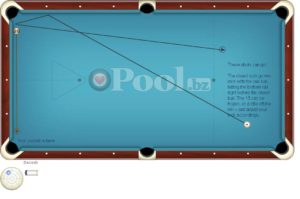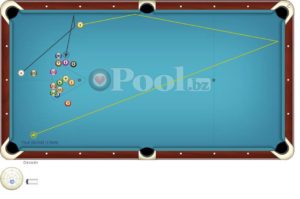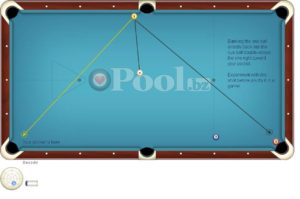| Defense into Offense | |||
| A better way to give your opponent the 15 ball hanging in their pocket (B). Draw the cue gently into the side of the stack, sending the 4 ball off the right side of the 15 & over by your own pocket (A). ‘Course, you have to make the hanging ball! | |||
 |
|
||
| Kick to your hole | |||
| Kick two rails to a thin cut towards your pocket. A lot higher percentage than it looks, and fairly safe, too. Even if the ball isn’t frozen to the end rail, the preferred aim is to kick two rails to the cut shot — not one rail. | |||
 |
|
||
| Controlling the CB / off angle Bank Shots | |||
| Supposedly one of Chicago ‘Bugs’ Rucker’s favorite banks. Inside English holds the cue ball near the head cushion, instead of the running English path that brings it out across the middle of the table, for a potential scratch in the side pocket. | |||
 |
|
||
| Kick Safety | |||
| Kicking at a ball near your opponent’s pocket — aiming for a ‘ticky’ off the 15-ball — with soft speed to end up with your opponent snookered. The ‘mirror system’ works pretty well for these shots, as long as you don’t get any accidental left or right english. | |||
 |
|
||
| Offense while playing Defense | |||
| Carom to behind the balls near your opponent’s pocket, at the same time kissing a ball off the stack towards your own pocket. | |||
 |
|
||
| Carom Split Shot | |||
| A ‘split shot’ — made by clipping the 1-ball first then caroming into the 2-ball, the cue ball goes nearly straight out the other side, so position might actually be obtained. These lie best squarely facing the pocket, and just over a ball apart. | |||
 |
|
||
| Combination Carom | |||
| Efren Reyes used this combination carom to move two balls from his opponent’s side — one to very near his own pocket. At the same time he drew the cue into the side of the rack. | |||
 |
|
||
| 2 Railer with CB in the stack | |||
| A long two cushion shot that sends the cue ball behind the stack at the same time. The cut helps put a little ‘hold-up’ english on the object ball that shortens the angle when the ball hits the far cushion. | |||
 |
|
||
| Back Cut Bank | |||
| A back cut bank — another ‘Bugs’ favorite. It’s not a kiss (you can see that the object ball is to the left of a straight line drawn to the pocket), but there is a possibility of scratching in pocket ‘C’. | |||
 |
|
||
| Rail first ‘ticky’ return to break | |||
| A rail first ‘ticky’ to return the break. The same shot would work to give your opponent the 2nd ball if it was hanging in the pocket, but in this case the 2nd ball was just less than a cueball’s width off the bottom rail, so no scratch! | |||
 |
|
||
| Kick Bank | |||
| Kick bank to clear opponent’s pocket & move ball near your own. Of course it’s safest when nothing goes on your opponent’s side of the table! | |||
 |
|
||
| Kick Carom Safety | |||
| Kick safety with a cue carom into the back of the stack, while sending a ball over to your own side. | |||
 |
|
||
| Kiss Bank | |||
| Train your eye to look for these when they come up. In this diagram, a three ball run out starts with a kiss-back bank. The 1-ball is about a chalk’s thickness off the cushion. If the 3-ball gets knocked in as shown, then once the other two balls are made and no balls are left on the table, the 3 gets spotted to become game ball! | |||
 |
|
||



